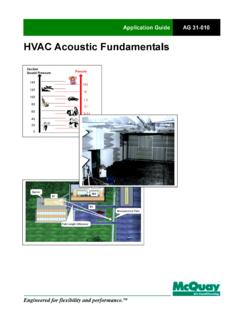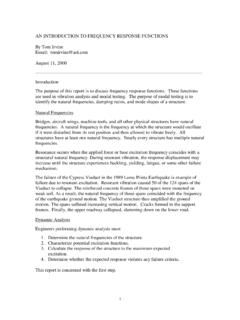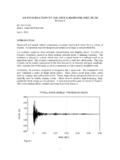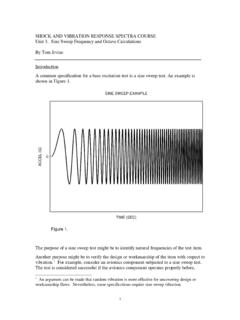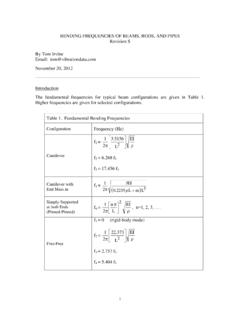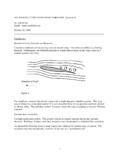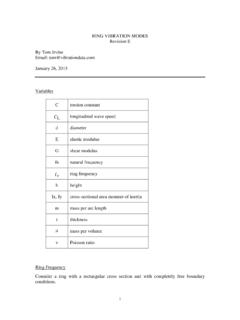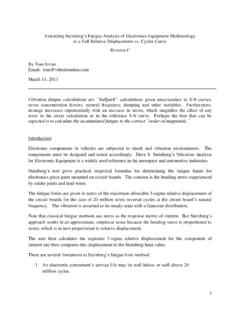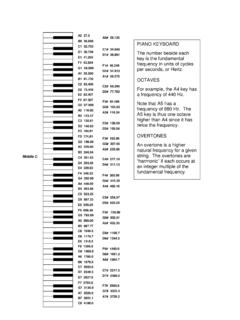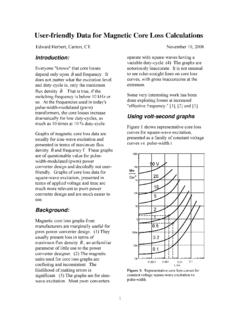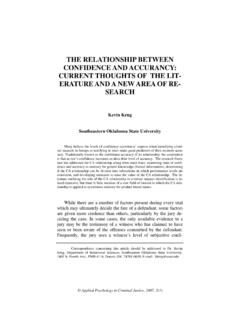Transcription of Implementing the Fatigue Damage Spectrum and …
1 Presented at the 79th Shock and Vibration Symposium: October 26 30, 2008 Orlando Florida 1 Implementing the Fatigue Damage Spectrum and Fatigue Damage Equivalent Vibration Testing Scot I. McNeill, Stress Engineering Services, Inc. 13800 Westfair East Drive Houston, TX 77041 In this paper, a type of response spectra in which Fatigue Damage is the ordinate is reviewed. Computation of this Fatigue Damage Spectrum (FDS) in both the time and frequency domains is discussed. The method of Fatigue Damage Equivalent vibration Testing (FDET) is discussed using the FDS as the measure of environment severity.
2 Improvements in each technique over previous work are introduced and the concepts are presented in a unified fashion. Efficient computation of the various elements involved in the FDS and FDET is discussed and examples are given. INTRODUCTION Various authors have introduced the concept of a Fatigue Damage Spectrum (FDS). The FDS is a type of response Spectrum , similar to the Shock Response Spectrum , except that the ordinate for this type of response Spectrum is the Fatigue Damage incurred in each single Degree Of Freedom (DOF) oscillator.
3 The concept was introduced as a method to examine the severity of frequency domain environments described by Acceleration Power Spectral Density (APSD) curves and time duration [1]. Certain requirements on the acceleration environment are required for validity of this method. Most importantly, the underlying process associated with the APSD must be a strongly mixed random process. In addition, the APSD must be approximately uniform over the half power bandwidth of each oscillator. In [1] the FDS, named the Damage Potential (DP), was proposed as a method used to evaluate the Fatigue potential of electrodynamic and electrohydraulic shakers as well as pneumatic hammer-driven repetitive shock shakers (at frequencies above 4 times the hammer rate).
4 Since the publishing of [1], the method has been used to evaluate the Fatigue potential of different shakers [2]. It is apparent that the FDS can be computed in the time domain from a time history of the acceleration environment by cycle counting and Damage accumulation techniques. Reference [3] discusses the use of the FDS to compare test specifications to measured environmental data. This reference illustrates the steps involved in computing FDS in the time domain and frequency domain. In addition, the FDS of a specified environment is computed in the time domain and frequency domain and the two FDS curves are shown to be equivalent.
5 The ability to compute the FDS in both the time and frequency domain and get equivalent results is the crux of the method of Fatigue Damage Equivalent vibration Testing (FDET). In this method a Gaussian random test environment and duration is derived such that it is Fatigue equivalent to a non-stationary environment described by an acceleration time history. The time history is normally obtained by direct measurement of the environment, such as placing accelerometers in a rocket payload module. Roughly speaking, the FDS of the non-stationary time history environment is computed and then the Gaussian random APSD curve and duration is derived which results in the same FDS.
6 Though most of the theoretical results have been published for some time, the concepts were first brought together in [4], and later in [5]. Commercial software Implementing this methodology has been developed recently, [6]. The purpose of this paper is to provide a unified theoretical framework for the FDS and FDET. Along the way improvements are introduced such as accounting for the APSD shape in computation of the FDS in the frequency domain, using rainflow cycles in computing the FDS in the time domain, and use of pseudo-velocity cycles (roughly proportional to stress cycles) in the computation of the FDS in both frequency and time domain.
7 Some other improvements in the FDET technique are introduced, including estimation of overall test duration and a refinement technique that accounts for spectral shape in Presented at the 79th Shock and Vibration Symposium: October 26 30, 2008 Orlando Florida 2 deriving the APSD from the FDS. Efficient computation of the various elements involved in the FDS and FDET is discussed and examples are given to illustrate the techniques. Fatigue Damage Spectrum In this section response spectra are briefly reviewed. Then the notion of the Fatigue Damage Spectrum is introduced.
8 Computation in the time domain and frequency domain is discussed. (PEAK) RESPONSE SPECTRA Response spectra have been used to characterize shock and vibration environments and compare their severity. Response spectra consider the effect of an environment on a set of Single Degree Of Freedom (SDOF) oscillators. In general, a set of SDOF oscillators is modeled with a range of natural frequencies (fn) and usually a single quality factor (Q). The response of each oscillator to the vibration environment is computed. Some feature of the response ( peak response) is computed and plotted vs.
9 Natural frequency. The most well known type of response Spectrum is the Shock Response Spectrum (SRS). The SRS is the peak oscillator response to a transient time history of the shock environment. Usually, the SRS is computed in the time domain by simulation of discrete time oscillator models [8]. A similar Spectrum of peak oscillator absolute acceleration to a Gaussian random environment, described by a PSD, is known as the Vibration Response Spectrum (VRS) [9]. The VRS is computed in the frequency domain by integrating the oscillator s frequency response to obtain the Root Mean Square (RMS) response.
10 The peak response for Gaussian random excitation can be approximated by multiplying the RMS response by sqrt(2*ln(fn*T)). Here T is the environment duration and ln( ) is the natural logarithm. There are several responses of interest for the SRS. Most often the absolute acceleration, relative displacement, and pseudo-velocity are computed. A relative displacement SRS is presented as a plot of peak relative displacement on the ordinate vs. natural frequency on the abscissa. The VRS can also be generalized to accommodate all the various ordinates (response types).
